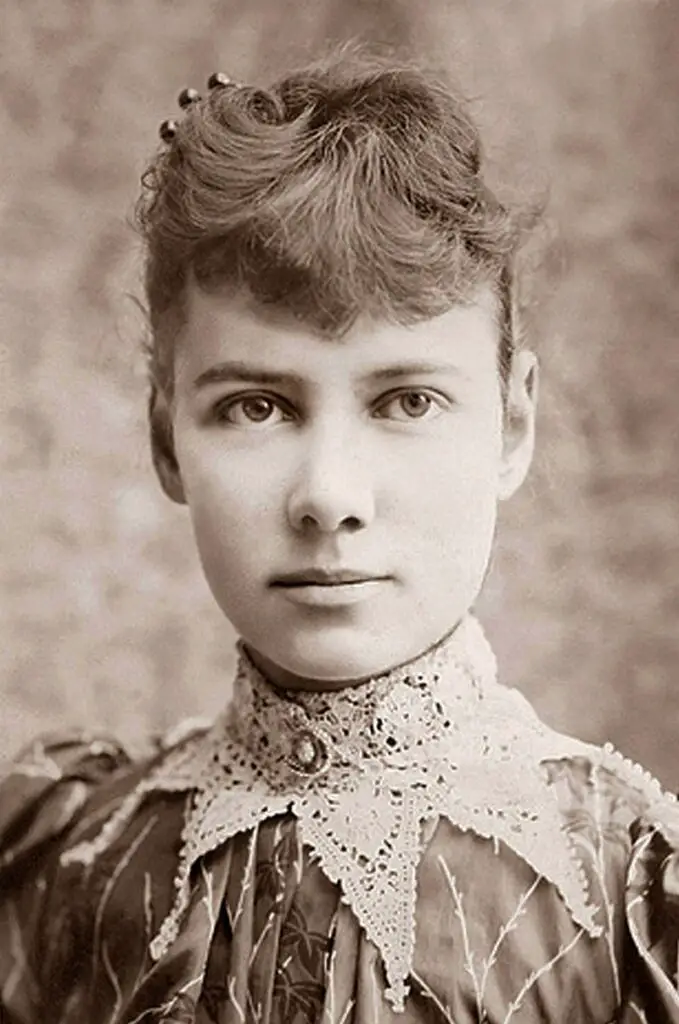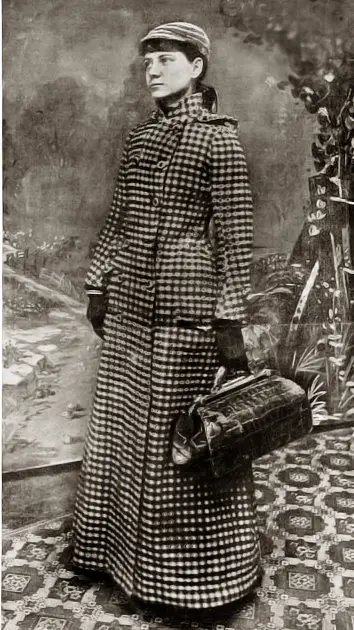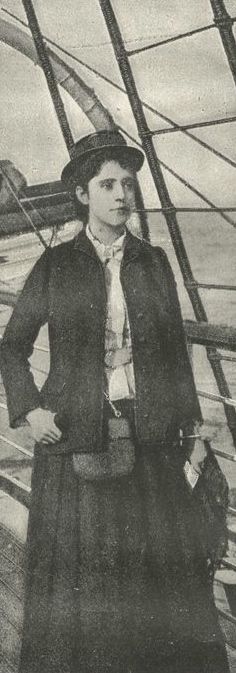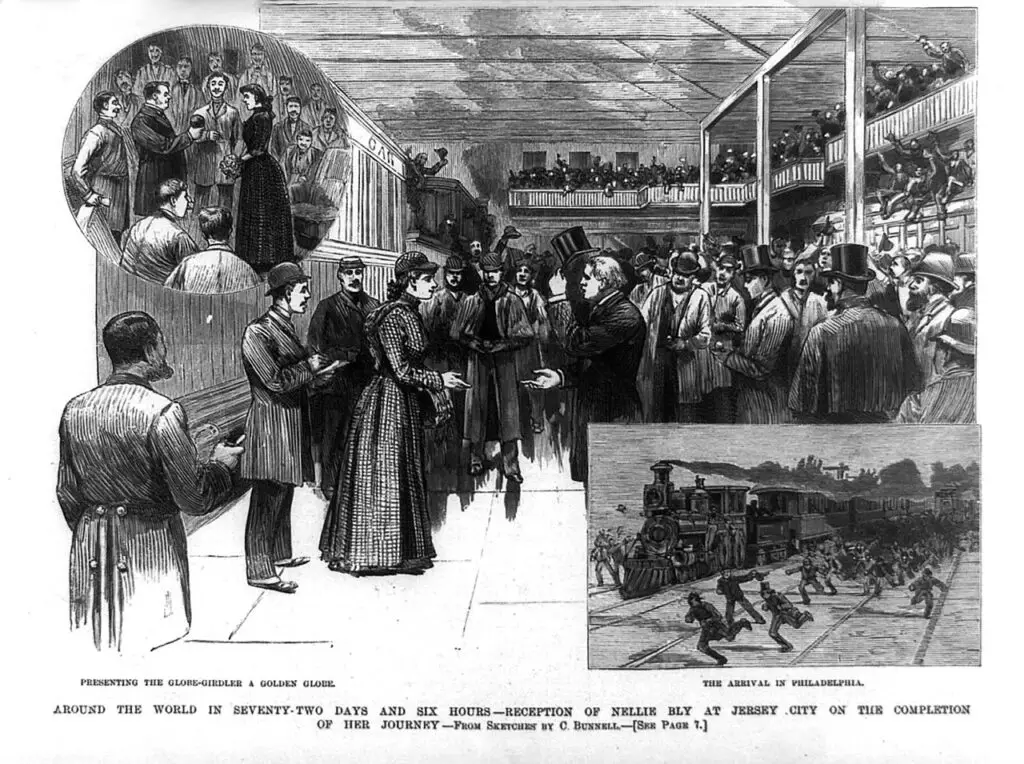Traveling around the world in the late 1800s was a challenging task, especially when trying to recreate the travels in the famous Jules Verne novel Around the World in Eighty Days. But one American journalist and a rival she didn’t know about took on the feat during the time period. They not only shattered how many days it took to travel around the world, but one also had enough time to interview Verne himself.
Jules Verne released Around the World in Eighty Days in 1872, and the story told of the fictional character named Phileas Fogg, who wagered that he could travel from the Reform Club in London around the world and end up back at the club in less than 80 days. Verne had written the story based on the innovations that had taken place worldwide, starting in 1869 with the Transcontinental Railroad across the United States, the opening of the Suez Canal, and the railway connecting the Indian sub-continent.
These innovations made travel around the world plausible, but testing Verne’s timeframe didn’t first happen until 1889. Two people, who were not doing it together, took on the challenge, and both were women. One of those women was an American journalist named Nellie Bly.
Bly was born as Elizabeth Jane Cochran in 1864 in Pennsylvania, the 13th child of a judge whom the town was named after. Her father died when she was six, and her mother later remarried. It became an abusive relationship, and her mother divorced, causing Cochran to leave school. The family then moved to Pittsburgh in 1880.
In 1885, Cochran read an article in the newspaper titled “What Girls Are Good For.” She was incensed with the piece and wrote a response to the paper under the pseudonym “Lonely Orphan Girl.” The editor of The Pittsburgh Dispatch, George Madden, was impressed with her writing and published her letter while also offering her an invitation to his office. He then had her write a full article in opposition to the one she had initially responded to, which led her to have a full-time writing position at the paper.
Madden thought she should have a new name to write under and suggested a name from a popular song, Nelly Bly, but changed Nelly to Nellie. She pushed away from what was expected of women writers of the time and began writing about sensitive social issues. This drew the ire of advertisers, and Bly eventually resigned. She became a freelance foreign correspondent and went to Mexico, delving into criticism of the dictatorship there, ultimately forcing her to leave this job.
She gained her first significant notoriety when she returned to the United States and went undercover for New York World, the publication of Joseph Pulitzer. She had herself intentionally committed to the notorious Blackwell’s Island Women’s Lunatic Asylum in New York. She gathered the information for a story over ten days about the mistreatment and abuse suffered by the women in the asylum. She had to be rescued by the publication. Her story “Ten Days in a Madhouse” led to many reforms for the mentally ill. Her articles were later published into a book in 1887.
Bly became known for her skills as an investigative reporter, but she soon set her sights on something different. She read Verne’s Around the World in Eighty Days in 1889 and approached her editor at New York World with an idea for a new story. She proposed that she would attempt an around-the-world journey in less time than it took the fictional character in Verne’s book.
She immediately had pushback from her idea, with her editor saying that it couldn’t be done because she was a woman. He stated that she would need a “protector” and to carry too many things on the journey. She was told that a man could only make the journey. Bly retorted that he could start a man the same day, and she would do it with another newspaper. Bly was granted her request by her editor, and she began to plan her trip. She was only 25 years old at the time.
Bly packed one piece of luggage with only essential items she thought she would need on the trip and set out from Hoboken, New Jersey, on November 14, 1889. Things didn’t start well. Bly got sick during the voyage across the Atlantic and spent much time in her room, but eventually, she overcame it and arrived in Southampton, England. That was when she learned that Jules Verne had heard about her voyage and wanted to meet her. The problem was Verne lived in Amiens, France, and the trip to meet the famous author would deviate from her planned schedule.
But Bly couldn’t pass up the offer and traveled two days to make the meeting with Verne. The author and his wife were waiting for Bly at the train station and then went to his home. But she didn’t stay long and was soon back on a train at 1:30 AM to cross France and Italy to the port of Brindisi. She then boarded a steamer and traveled across the Mediterranean to Port Said in Egypt, where the new Suez Canal began.
Bly went through the canal into the Red Sea to the Port of Aden and then on to Sri Lanka. Here she submitted a report to New York World by telegraph. When a telegraph station wasn’t available, she would mail reports on her progress. Bly’s next stop would be a 3,500-mile sea journey to Hong Kong, but she had to wait five days in Sri Lanka before leaving. During her journey and between reports, the paper back in New York continued the interest in the story by offering prizes to readers who could guess how long it would take her to go around the world.
She made a stop in Singapore, where she picked up a monkey she named McGinty. Though the weather was terrible when she set sail again for Hong Kong, the boat she was on arrived early, right before Christmas Day. Unbeknownst to Bly, however, she had been racing a rival the entire time. A competing publication called Cosmopolitan had heard about her journey and enlisted a 28-year-old woman named Elizabeth Bisland to take on the challenge. She had left New York on the same day as Bly, but instead of going across the Atlantic, Bisland traveled west across the United States.
Bly had no idea she was being challenged until she was told Bisland had made it through Hong Kong days before her. Bly wasn’t concerned and stated that this was not a race, but her attitude changed when she was delayed due to a storm from Hong Kong to Yokohama, Japan.
She made it across the Pacific Ocean from Japan to San Francisco and reached the city on January 21, 1890. She was a day ahead of schedule, but her route by rail to the east across the U.S. was delayed because of snowstorms. Bly had no idea how far Bisland had gotten, but her rival was in trouble. Brisland had already made it to Southampton, where Bly had once been, but the ship she was going to take to New York had been canceled. Bisland went to Ireland to catch another ship, but it was a much slower ship than the one she had originally been scheduled on.
In order to make sure Bly was no longer delayed, Joseph Pulitzer, New York World’s owner, chartered a private train to finish the remaining 2,577 miles across the U.S. It was dubbed the “Miss Nellie Bly Special” and set speed records while whisking Bly across the country. She made the journey in 69 hours and arrived back in New Jersey where she started on January 25, 1890, at 3:51 PM, to much fanfare. She had shattered Verne’s 80 days and came in at 72 days, 6 hours, 11 minutes, and 14 seconds for her around-the-world trip. Bisland also beat the 80-day mark but was behind Bly by five days.
Bly’s journey catapulted Verne’s book back into the mainstream, and it was reissued into ten new editions. Five years after her trip, she married a millionaire manufacturer named Robert Seaman, who was 40 years older than her. Bly retired from reporting and became a businesswoman, but Seaman died, and his business went bankrupt. Bly returned to what she knew best and began to write again, covering the news items of the time and being a reporter on the frontlines of World War I. Bisland also continued to write but never spoke of her trip again after completing it and moved to Great Britain.
Bly died in 1922 at the age of 57, and Bisland died in 1929, both succumbing to pneumonia. Both pioneering women were buried in Woodlawn Cemetery in New York City.
Sources: History Extra, Pan MacMillan, Smithsonian Magazine, The Evening World






